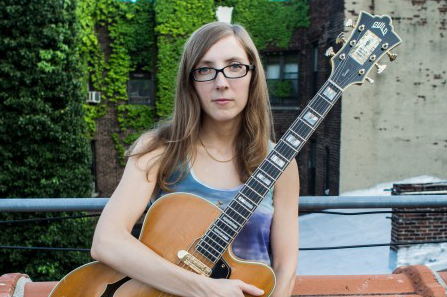Oct 28, 2025 10:47 AM
In Memoriam: Jack DeJohnette, 1942–2025
Jack DeJohnette, a bold and resourceful drummer and NEA Jazz Master who forged a unique vocabulary on the kit over his…

Code Girl is a new vocal ensemble that performs songs by Mary Halvorson (pictured). The group appeared at the Jazz Gallery June 10–11.
(Photo: Peter Gannushkin)This year, in response to complaints about a lack of guitarists in its commissioned residency series, Manhattan’s Jazz Gallery named only six-stringers for the three slots: Rafiq Bhatia, Gilad Hekselman and Mary Halvorson. The latter took the opportunity to create a new band and a new challenge for herself, bringing both to the nonprofit’s fifth-floor Chelsea stage for four sets on the weekend of June 10–11.
The band was dubbed “Code Girl” (the name coming from a comment made by multi-instrumentalist Anthony Braxton, with whom Halvorson frequently collaborates), and the challenge was to write and arrange vocal pieces for an ensemble. Halvorson has done song projects in the past (includig her duo with violist Jessica Pavone and her duo/trio People with drummer Kevin Shea and bassist Kyle Forester), but she hasn’t taken on full-band, true-to-form song arrangements before. It suited her well; some of her recent band projects have cried out for a singer.
Halvorson is an immediately recognizable guitarist, known for her thick, visceral plucking technique and sudden swoops enhanced by a Line 6 effects box. She continues to challenge herself as a composer and leader. At times her bands seem designed to explore a very specific idea, sometimes extremely specific. Her trio Crackleknob, with bassist Reuben Radding and trumpeter Nate Wooley, was named for a faulty wire in her big Guild hollowbody guitar that caused a noise she rather liked in one of the knobs.
For Code Girl she expanded the trio Thumbscrew (with drummer Tomas Fujiwara and bassist Michael Formanek) into a quintet, adding trumpeter Ambrose Akinmusire and vocalist Amirtha Kidambi.
Halvorson began the second set on the first night by playing a three-note riff repeated in a staggered rhythm, dropping the pitch then swooping up to the top of the neck as Kidambi’s voice came in. Her sound was reminiscent of Cassandra Wilson’s early days with Steve Coleman and Henry Threadgill, but often with a more insistent vibrato. She fluidly intoned Halvorson’s rather dense lyrics from the opening “My Mind I Find In Time”: “I have here in my rotation / it is not predictable, my mind / potential to deal a dangerous lie / it is not predictable, my mind / and if i disappear, it is for this / it is not predictable, my mind.”
Formanek and Fujiwara played as a piece, Halvorson generally holding steady with them. Kidambi and trumpeter Ambrose Akinmusire rarely worked in unison or harmony but still functioned as the front line. “The Unexpected Natural Phenomenon” began on a mournful note, Kidambi wearing a concerned expression on her face, but later shifted into an off-kilter shuffle that allowed Kidambi a wordless solo followed by a quickly fluttering trumpet solo by Akinmusire. A rock solid drum solo made it not just the players’ showcase but the strongest of the eight pieces they played.
The band was impressive after only having rehearsed the day before, and there’s certainly room to grow into Halvorson’s unusual, sometimes proggy songs (she takes a measure of inspiration from Annette Peacock, whose “Blood” she covered on her solo guitar record Meltframe last year).
Kidambi had an odd way of falling in and out of the emotion of the songs, but clearly had plenty to worry about as she negotiated Halvorson’s paragraphs of lyrics. At one moment she ended up buried by the band.
As interesting as the layered pieces were, the edges were a bit boldly drawn, something that will surely smooth out as the group develops. But the hard part is done: they’ve broken the code. Now they just need to decipher their messages.

Jack DeJohnette boasted a musical resume that was as long as it was fearsome.
Oct 28, 2025 10:47 AM
Jack DeJohnette, a bold and resourceful drummer and NEA Jazz Master who forged a unique vocabulary on the kit over his…

D’Angelo achieved commercial and critical success experimenting with a fusion of jazz, funk, soul, R&B and hip-hop.
Oct 14, 2025 1:47 PM
D’Angelo, a Grammy-winning R&B and neo-soul singer, guitarist and pianist who exerted a profound influence on 21st…

To see the complete list of nominations for the 2026 Grammy Awards, go to grammy.com.
Nov 11, 2025 12:35 PM
The nominations for the 2026 Grammy Awards are in, with plenty to smile about for the worlds of jazz, blues and beyond.…

Drummond was cherished by generations of mainstream jazz listeners and bandleaders for his authoritative tonal presence, a defining quality of his style most apparent when he played his instrument unamplified.
Nov 4, 2025 11:39 AM
Ray Drummond, a first-call bassist who appeared on hundreds of albums as a sideman for some of the top names in jazz…

Jim McNeely’s singular body of work had a profound and lasting influence on many of today’s top jazz composers in the U.S. and in Europe.
Oct 7, 2025 3:40 PM
Pianist Jim McNeely, one of the most distinguished large ensemble jazz composers of his generation, died Sept. 26 at…





